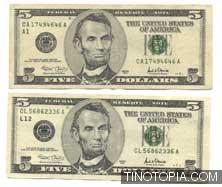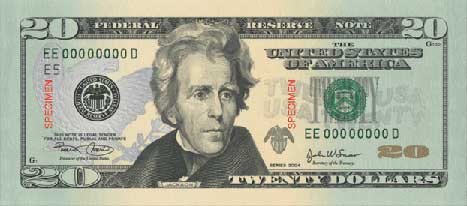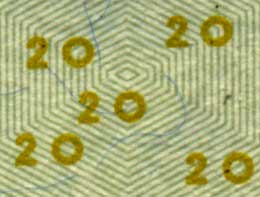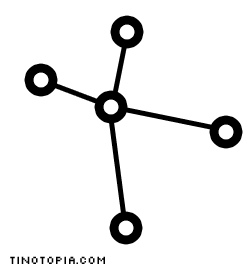
|
|
|
Monday 12 January 2004
Copyright Issues
Counterfeiting, Adobe Photoshop, Copyright, and the Future - Part I A little over a month ago, I wrote something here that I illustrated with a picture of a pair of $5 bills.
This image would be impossible using the latest versions of the $20 bill and Adobe Photoshop.
Trouble is, the software doesn’t just prevent you printing accurately-representative copies of currency, it prevents you doing anything at all to images of currency. If you attempt to scan currency, or open a file containing an image of currency, or paste in something from the clipboard that contains an image of currency, it’ll refuse — even if you are using the Bureau of Engraving and Printing’s own ‘specimen’-marked samples.
In the U.S., at least, there are specific laws governing the use of currency images: you’re allowed to use them, as long as they are less than 75% of the ordinary size, or greater than 150%, and as long as they’re one-sided. But, given that Photoshop is the tool of choice for things like this, you are effectively no longer permitted to do so — and without any debate in Congress about it, either. It appears that this has to do, in part, with these little ‘20’s on the back of the new bill:
If you look at other currencies, you’ll find similar things, little circles in decorative or random patterns. But they’re not random at all, and their decorative value is secondary; on a lot of modern currency, you’ll find these little circles in constant relation to one another, like these:
You find the same thing on bills from a number of countries:
Now, what concerns me is not that this is going to put a crimp in my bogus-$20 operation. What concerns me is that there’s now a class of images that you effectively cannot make use of, even though such use is perfectly legal. There’s no defense for people who want to be able to make their own twenties, of course, but there are a lot of other uses for images of money. This move echoes what’s been going on in the copyright industry of late. The problem with counterfeit currency isn’t (usually) that there’s so much counterfeit currency floating around that the issuing bank goes broke redeeming bogus notes; the problem is that, the more counterfeit currency there is, the less people trust the stuff, and the less the currency is trusted, the less it’s worth. A copyrighted work — let’s say a DVD of Gigli — has its value diminished by counterfeiting, too. (More accurately, a movie has its value diminished by piracy in general, of which counterfeiting is just one category. For the purposes of this discussion, it’s all the same.) When Gigli came out in the theater for the first time, it cost you around $10 a head to see it. Currently, you can buy a DVD of it for $25 at Amazon, a DVD that you can watch time and time again, in the company of friends. Soon, you’ll be able to buy the DVD in the giant bin of B-movies at Wal-Mart for $3, and not long after that you’ll find it showing in the wee hours on the Hallmark Channel, interspersed with commercials for Tom-Vu-esque real estate scams, porn chat lines, and Billy Mays products. Every time the movie is shown, it loses a bit of value. The value of something like a movie never actually drops to zero — though in the case of Gigli, I’m not so sure that’ll be true — but certainly in the early years of a movie’s life, every person that sees the movie costs the studio something in that the value of the movie as a product is diminished. (Good movies are ones where this value diminishes the least every time it’s watched.) Columbia Pictures wants to make sure that they capture as much of this drop in value as possible in the form of dollars flowing into their bank accounts. The more unauthorized copies of Gigli there are out there, the more people can see the movie without any money going to Columbia, and the more money — in terms of the value of the unseen film — they lose: so Columbia opposes and fights piracy. However, much of the copyright industry, in fighting piracy, is these days taking the opportunity to expand its control of how its information is used, far beyond the control necessary to ensure the value of its product — in much the same way that the ham-fisted anti-counterfeiting software now built into Photoshop goes beyond what’s necessary to make the product useless for counterfeiters. Next: What this has to do with copyright Posted by tino at 11:40 12.01.04This entry's TrackBack URL::
http://tinotopia.com/cgi-bin/mt3/tinotopia-tb.pl/227 Links to weblogs that reference 'Counterfeiting, Adobe Photoshop, Copyright, and the Future - Part I' from Tinotopia.
http://www.zefrank.com/zesblog/archives/2005/04/tinotopia_count.html
Excerpt: Tinotopia: Counterfeiting, Adobe Photoshop, Copyright, and the Future - Part I... Weblog: ze's blog Tracked: April 25, 2005 01:11 PM
Photoshop CS2 & Counterfeiting
Excerpt: Thinking about manipulating some currency? Think again... apparently Adobe has been pushed by the government to include currency scanners in their software. http://www.tinotopia.com PS CS2 can detect specific currency elements and prevent you fro... Weblog: Behind R4NT Tracked: May 10, 2005 07:09 PM Comments
The unfortunate thing about the Adobe ‘feature’ is that I’m sure the majority of the Congress doesn’t see any problem with this and might even believe that this will help prevent counterfiting. Posted by: Paul Johnson at January 12, 2004 02:07 PM I found the dots on the back of a Swedish 100 Kronor note I posess. At current exchange rates the bill is worth $13.50. Posted by: RRP at January 20, 2004 03:47 PM Has anyone actually verified that these circles are the pattern that Adobe is balking at? It would be easy to attempt to create such an image and then scan it back in, or possibly just cut and paste it. This is not a difficult problem to reverse-engineer if you’re right about what’s triggering it. Posted by: at September 10, 2005 04:54 PM |




